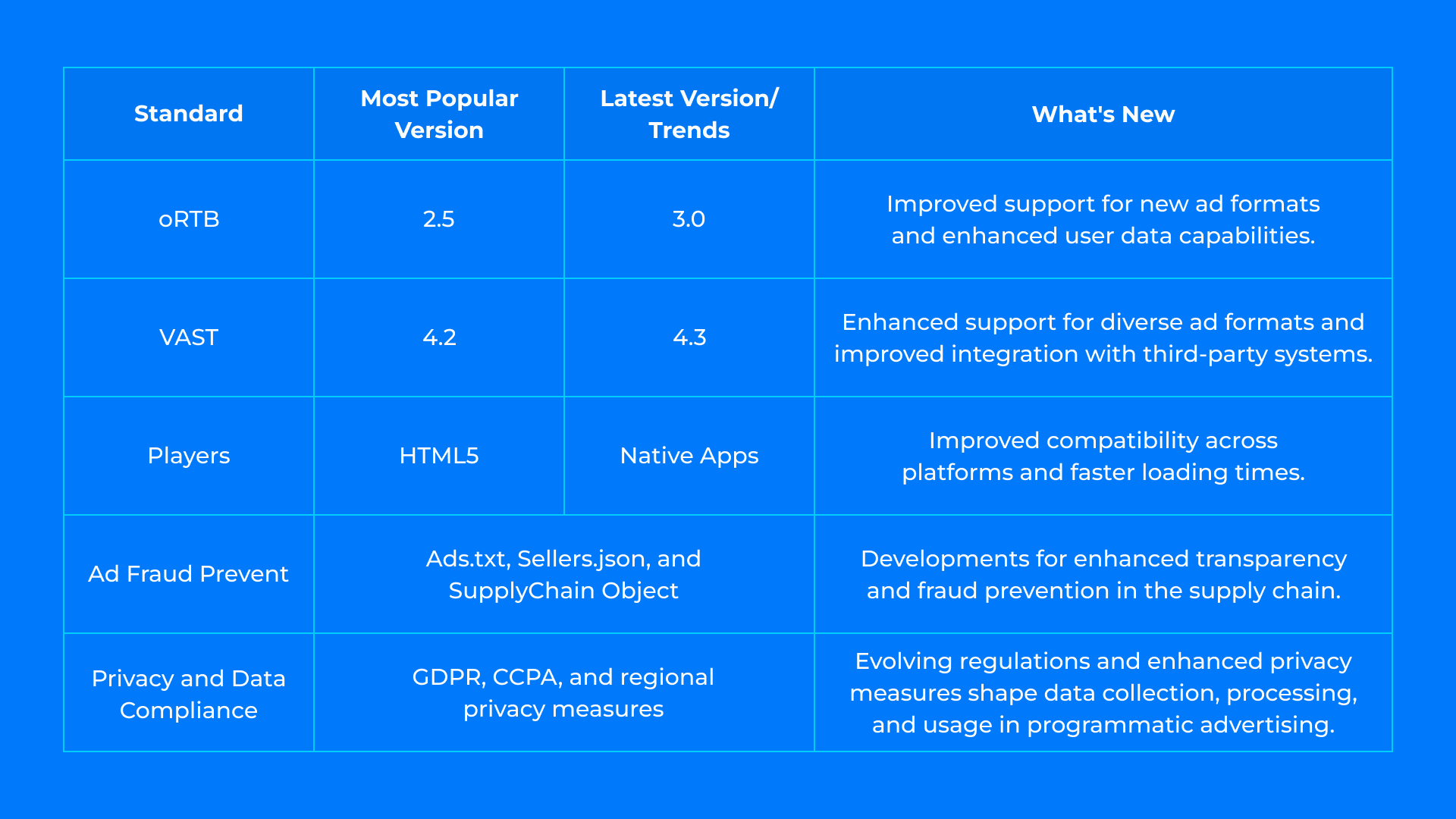Navigating the dynamic landscape of digital publishing requires a close focus on maximizing revenue streams for sustained growth and success. Programmatic advertising has emerged as a powerful tool for publishers seeking to optimize revenue generation. However, programmatic complexities can be like traversing a dense forest without a map without a clear strategy.
Table of Contents
- Update Your Stack to the Latest Industry Standards
- Adopt Privacy-Focused Advertising
- Make the AI/ML Bloom Work For You
- Use Your Data to Drive Valuable Engagement
- Take a Detailed Approach to Setting Price Floors
- Evaluate the Power of Programmatic Direct
- Consider Latest Monetisation Trends
- Take UX as a Priority
- Bottom Line
Update Your Stack to the Latest Industry Standards
Maximizing revenue potential hinges on updating your technology stack to the latest industry standards for oRTB, VAST, player technologies, and other pertinent components. These updates enhance functionality and unlock new avenues for revenue generation.

Keeping pace with the latest industry standards empowers advertisers, publishers, and technology providers to harness advanced capabilities, fostering a more efficient and transparent programmatic advertising ecosystem. This proactive approach fuels revenue growth and cultivates trust and sustainability within the advertising field.
Adopt Privacy-Focused Advertising
The evolution away from third-party cookies represents a pivotal moment in digital advertising. Embracing a cookieless future isn’t merely a hurdle but a chance to revamp and elevate advertising practices, with a strong focus on user privacy and data security. For publishers, navigating this transition demands a strategic transformation. They must embrace new technologies and methodologies, including strengthening their first-party data capabilities and exploring collaborations with platforms offering cookieless solutions. Publishers must remain adaptable and well-informed, prepared to adopt emerging standards and technologies to thrive in this evolving landscape.
Make the AI/ML Boom Work For You
As we stay into the first half of 2024, Artificial Intelligence and Machine Learning have evolved into indispensable tools shaping the future of website monetization. These technologies are revolutionizing how publishers optimize ad placements, personalize user experiences, and maximize revenue. AI and ML algorithms sift through extensive data sets to comprehend user preferences and behaviors. This data-driven approach empowers publishers to showcase the most pertinent ads to each user, thereby enhancing the likelihood of user engagement and CTRs. For example, AI can pinpoint optimal ad formats and placements based on user interaction patterns, ensuring that ads seamlessly integrate with the user experience rather than disrupt it.
Use Your Data to Drive Valuable Engagement
In today’s digital ads field, publishers are encouraged to shift their focus toward understanding how users interact with content across their web properties. By leveraging analytics effectively, publishers can translate insights into actionable strategies by creating niche audience segments. These segments enable advertisers to target specific interests, regions, and passions, leading to more personalized online experiences and ultimately driving higher engagement and revenue.
The key lies in investing in robust data analytics and utilizing relevant insights to assist clients in reaching the right audience with tailored messages. It’s important to recognize that there’s no all-purpose approach to achieving this goal. Various factors, such as business model and region, significantly influence how publishers utilize their audience data to optimize advertising strategies and enhance user experiences.
Take a Detailed Approach to Setting Price Floors
In programmatic advertising, publishers use price floors akin to reserve prices in real-world auctions. These floors establish a minimum value for digital inventory, ensuring optimal revenue without undervaluing it. To set effective price floors, publishers must adopt a targeted approach, identifying inventory segments that attract higher demand based on factors like geography, page position, video type, and ad units. Experimenting with tailored price floors for these segments maximizes revenue potential.
It’s crucial to communicate price floors transparently to buy-side partners, enabling informed bidding decisions. Regularly revisiting and adjusting price floors based on market trends, such as raising them during peak holiday periods, ensures they remain aligned with revenue goals and market dynamics in programmatic advertising. This approach helps optimize monetization strategies for publishers.
Evaluate the Power of Programmatic Direct
Programmatic Direct presents a valuable opportunity for publishers seeking to optimize revenue through programmatic strategies. Unlike traditional real-time bidding auctions, Programmatic Direct involves direct negotiations and guaranteed deals between publishers and advertisers. To harness the power of Programmatic Direct effectively, publishers should carefully evaluate their inventory, audience segments, and advertiser relationships. Publishers can unlock additional demand and revenue streams by identifying suitable opportunities for direct deals and optimizing pricing strategies. Incorporating Programmatic Direct strategically into their approach empowers publishers to diversify revenue sources and strengthen their position in the dynamic digital advertising landscape.
Consider Latest Monetization Trends
CSAI/DAI/SSAI
CSAI, while a longstanding method, has faced challenges due to potential negative user experiences, especially with slower internet connections or larger ad content sizes. As more efficient alternatives have emerged, CSAI’s popularity has waned.
SSAI stands out for its ability to drive ad performance through real-time delivery and seamless integration into video streams on the server side. This approach guarantees the same user experience on different devices and internet speeds and offers real-time ad delivery and targeting capabilities.
DAI represents the forefront of ad insertion technology, providing unparalleled targeting and flexibility by delivering ad content in real time. This dynamic method leverages user behavior and preferences for precise ad placement, ultimately driving higher engagement and conversion rates.
Interactive and Immersive Ads
Interactive and immersive ads are transforming monetization strategies. These innovative formats move beyond traditional banners and videos, engaging users with dynamic experiences. For publishers, integrating these experiences can unlock new revenue streams and enhance user satisfaction in a competitive digital landscape.
Interactive ads encourage active participation through quizzes, games, or product demos within the ad, driving higher engagement and brand awareness.
Immersive ads utilize technologies like augmented reality or virtual reality to create captivating brand experiences, fostering strong emotional connections with users.
Non-Intrusive Ad Formats
Non-intrusive ad formats are gaining traction in digital advertising, focusing on seamless integration into content without disrupting user experiences. These formats include native ads that blend naturally with surrounding content and contextual ads that appear relevant to user interests, enhancing engagement and interaction. The shift towards non-intrusive ad formats emphasizes user-centric advertising, delivering personalized messages effectively. By adopting these formats, businesses can improve user satisfaction, increase click-through rates, and drive higher monetization, reflecting the evolving landscape of digital advertising.
Take UX as a Priority
Addressing page latency has long been a challenge for programmatic publishers. User experience is critical for driving engagement with ad content because no one likes waiting. To address this issue, footer bidding has emerged as a solution that prioritizes loading page content before ads.
Unlike traditional header bidding, which loads ads early in the page’s rendering process, footer bidding delays ad loading until the end of the page (in the footer). This approach preserves website performance and user experience, ensuring users remain engaged and attentive to content and ads.
By prioritizing a seamless browsing experience, publishers can maintain website rankings and maximize user engagement with ads. In today’s digital publishing landscape, striking this balance is essential for optimizing user experience and advertising effectiveness.
Our tech staff and AdOps are formed by the best AdTech and MarTech industry specialists with 10+ years of proven track record!

Bottom Line
This checklist is a roadmap for publishers aiming to boost their revenue through effective programmatic strategies. By following these key steps, publishers can harness the full strength of programmatic advertising and achieve substantial revenue growth. It’s worth noting that improving your results depends on many factors and often combined approaches. However, with the right strategy, you will increase your business’s performance.
In the evolving programmatic world, publishers prioritize maximizing revenue and optimizing user experiences. Programmatic advertising offers powerful tools to achieve these goals by updating technology stacks, embracing privacy-focused strategies, leveraging AI and ML for personalized experiences, and utilizing data analytics to drive engagement. Setting precise price floors, exploring Programmatic Direct opportunities, and adopting the latest monetization trends, such as interactive and non-intrusive ad formats, are essential strategies to diversify revenue streams and innovate in digital advertising.
By prioritizing user experience through techniques like footer bidding, publishers can maintain website performance while enhancing engagement with content and ads. So, integrating these strategies into a comprehensive programmatic approach empowers publishers to navigate the digital landscape effectively, drive revenue growth, and deliver exceptional user experiences.
This Article's Ad Tech terms

